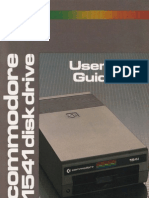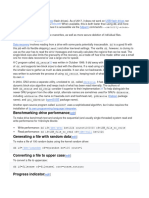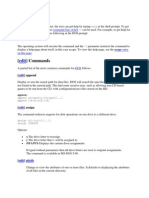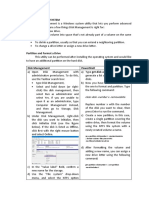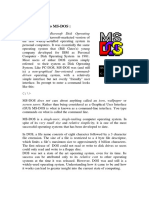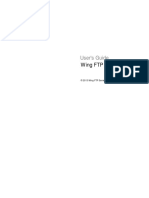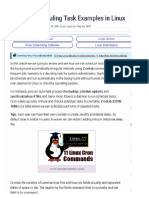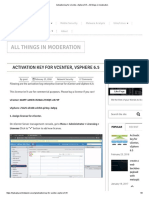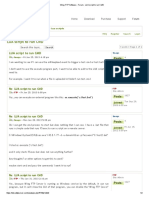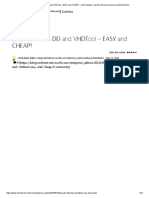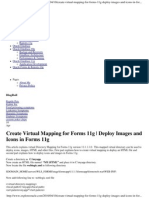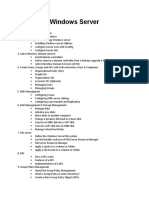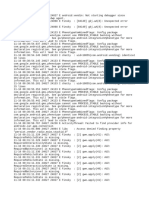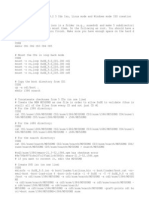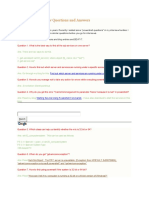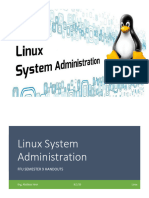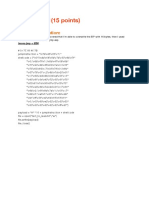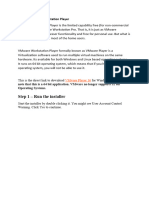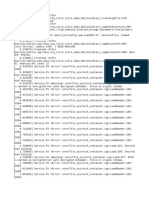2/21/2019 chrysocome.
net - dd for windows
chrysocome.net
Site chrysocome.net>>dd
Map
Home dd for windows
Projects
dd - convert and copy a file
Downloads
Library
Links This version does not actually do any conversion but it allows the flexible
Contact copying of data under in a win32 environment. At the moment block
Blog devices under Win9x are not supported but that will be added soon.
Search
Read more in the Wikipedia entry for dd
Usage
dd [bs=SIZE[SUFFIX]] [count=BLOCKS[SUFFIX]] if=FILE of=FILE
[seek=BLOCKS[SUFFIX]] [skip=BLOCKS[SUFFIX]] [--size] [--list] [-
-progress]
bs is the block size. The block size can be specified in bytes or with one of
the following suffix
Description Suffix Size
Characters c 1
Words w 2
Double Words d 4
Quad Words q 8
Kilobytes k 1,024
Megabytes M 1,048,576
Gigabytes G 1,073,741,824
The default block size is 512 which will work for most files and devices but
the copy will be a lot faster if you use a larger block size. For example a
floppy disk read with bs=1k count=1440 takes almost twice as long than if
you use bs=1440k count=1. Don't make the block size too large because
windows will run out of memory. 1M is probably a good size and upper limit.
Most CD/DVDs have a 2k sector size and probably will not work with a
block size which is not a multiple of that.
skip is the distance to skip over the input file before reading is
commenced. It is in blocks so the distance will be skip * blocksize. You
can also use a suffix here so skip=1k will skip 1024 blocks. You can
remember that skip relates to the input file by thinking of a 'skipping rope'.
seek is the distance to seek over in the output file before writing is
commenced. It is also in blocks do the distance will be seek * blocksize.
You can also use a suffix here so seek=1k will seek 1024 blocks. You just
have to remember that if skip is for in then seek is for out.
count is the number of blocks to copy. If it is not specified then the dd will
continue until the end of the file/device is reached. On many usb devices
this is not reliable so you should use --size to guess the size of the
device, see below. You can also use a suffix here so count=1k will copy
1024 blocks.
http://www.chrysocome.net/dd 1/6
�2/21/2019 chrysocome.net - dd for windows
Using --size
Traditionally when using dd, if you wanted to copy an entire device, you did
not specify a block count and dd would read until it reached the end of the
device. If you tried to read past the end of the device, the data up to the
end of the device would be returned and if you kept reading you would get
an error message. Windows however does not always do this so --size
will tell dd to figure out the size of the device and make sure it does not
read past that point. This is important for USB sticks which stop working if
you read past the end of them. This is not on by default because getting the
correct size of the device is not always possible. Some devices also keep
returning bogus data past the end of the device without returning a suitable
error code
Using --list
Windows provides a number of ways to name a device. The --list will
output the preferred names. Under NT4, only the \\?
\Device\Harddisk<n>\Partition<n> method is available. Partition0 is
the entire disk. Under Windows XP, some partitions may not have a
Volume device. In this case you can still use the
Harddisk<n>\Partition<n> name.
Windows 2000 and later have Volume devices which are unique GUIDs
which identify a disk or partition (what MS call a Volume). These are listed
along with any mount point that they may be mounted on. Most of the time
this is a drive letter but it may be a path on another filesystem. If you want to
read the underlying device, do not include the trailing \ character. If the
volume is not mounted there is no easy way to identify it so be careful.
Under XP SP2, many partitions can not be read directly, even if they are
not in use. There is a work around which I call reading partitions via the
back door.
Sample output
dd --list
rawwrite dd for windows version 0.4beta1.
Written by John Newbigin <jn@it.swin.edu.au>
This program is covered by the GPL. See copying.txt for details
Win32 Available Volume Information
\\.\Volume{5cd94d2c-3251-11d9-9444-806d6172696f}\
link to \\?\Device\HarddiskVolume1
fixed media
Mounted on \\.\c:
\\.\Volume{129b1243-3252-11d9-b167-806d6172696f}\
link to \\?\Device\CdRom0
CD-ROM
Mounted on \\.\r:
\\.\Volume{129b1242-3252-11d9-b167-806d6172696f}\
link to \\?\Device\Floppy0
removable media
Mounted on \\.\a:
\\.\Volume{e3429891-0eb9-11da-b18f-000d60dc98cd}\
link to \\?\Device\Harddisk1\DP(1)0-0+3
removable media
Mounted on \\.\d:
NT Block Device Objects
\\?\Device\CdRom0
\\?\Device\Floppy0
\\?\Device\Harddisk0\Partition0
link to \\?\Device\Harddisk0\DR0
Fixed hard disk media. Block size = 512
\\?\Device\Harddisk0\Partition1
link to \\?\Device\HarddiskVolume1
http://www.chrysocome.net/dd 2/6
�2/21/2019 chrysocome.net - dd for windows
\\?\Device\Harddisk1\Partition0
link to \\?\Device\Harddisk1\DR2
Removable media other than floppy. Block size = 512
\\?\Device\Harddisk1\Partition1
link to \\?\Device\Harddisk1\DP(1)0-0+3
Removable media other than floppy. Block size = 512
Virtual devices
/dev/zero
/dev/random
Using --progress
--progress is an non-standard enhancement to dd which will show you
progress as each block is copied.
Virtual devices
Virtual devices are a new feature in version 0.4beta1.
Because windows does not have devices like the unix /dev/zero or
/dev/random these have been implemented inside dd. You can use these
as input files to supply an infinite amount of zeros or pseudo random data.
Standard I/O
Standard Input (stdin) is now the default input file if you do not specify a
value for if. You can also explictly use stdin with if=-. Standard Out
(stdout) is now the default output file if you do not specify a value for of. You
can also explictly use stdout with of=-. Progress and error messages are
written to Standard Error (stderr). This allows the use of dd with pipe
commands.
Safety with --filter=
To prevent accidental overwriting of the wrong disk, a safety filter can be
enforced. Available filters are:
fixed Only write to a fixed disk
removable Only write to a removable disk
disk Only write to any kind disk
partition Only write to a partition
You can enforce a filter by renaming dd.exe to dd-<filter>.exe. For
example, dd-removable.exe can only write to removable disks like USB
and CF, making sure that you don't accidently write to a fixed hard disk.
Examples
Make an image of a floppy disk:
dd if=\\.\a: of=c:\temp\disk1.img bs=1440k
Write the image back to a floppy disk:
dd if=c:\temp\disk1.img of=\\.\a: bs=1440k
Rip an .iso from a CD
dd if=\\?\Device\CdRom0 of=c:\temp\disc1.iso bs=1M
Read a partition from a USB memory device
dd if=\\.\Volume{c18588c0-02e9-11d8-853f-00902758442b}
of=c:\temp\usb1.img bs=1M
http://www.chrysocome.net/dd 3/6
�2/21/2019 chrysocome.net - dd for windows
Read the entire USB memory device
dd if=\\?\Device\Harddisk1\Partition0 of=c:\temp\usb2.img bs=1M
--size --progress
You can write to any file or block device which windows will allow you to
write to. You can use the standard \\.\ notation for win32 exported
devices or the dd specific \\?\ notation to access windows native devices.
Note: You can not write to a CD with this program. Get microsoft cdburn
from the windows XP resource kit.
Note: Floppy disks are extremely unreliable. If you get errors, please try
another floppy disk or reformatting the disk.
Downloads for dd family
Program Version Content Format Platform Download
dd 0.6beta3 Binary .zip Windows dd-0.6beta3.zip
dd 0.6beta3 Source .zip Delphi dd-0.6beta3.src.zip
dd 0.6beta1 Source .zip Delphi dd-0.6beta1.src.zip
dd 0.5 Binary .zip Windows dd-0.5.zip
dd 0.4beta4 Binary .zip Windows dd-0.4beta4.zip
dd 0.4beta4 Source .zip Delphi dd-0.4beta4.src.zip
Installation Instructions
Changes in version 0.6beta3
add errorlevel exit code
progress is written to stderr
Changes in version 0.6beta2
Implemented of=/dev/null which will just throw away the data
skip on stdin now works
fix checking size of floppy disks
Changes in version 0.6beta1
--progress output is in the same unit as bs is specified with
new filter type 'file' which will Only write to a fileystem file
new feature id=<drive>/od=<drive> for input disk and output
disk. if <drive> is the only partition on a disk, then the entire
disk is selected. Eg: if you insert a USB disk and it is
mounted as f: then 'id=f:' will select the USB disk (not just the
partition like if=\\.\f: would do)
Changes in version 0.5
count, seek and skip can now use a multiplicative suffix like bs
stdin and stdout are now the defaults
Changes in version 0.4beta6
Implemented of=- for stdout
Renamed if=- for stdin
Messages are now printed to stderr
Changes in version 0.4beta5
http://www.chrysocome.net/dd 4/6
�2/21/2019 chrysocome.net - dd for windows
If a partial block write fails, the buffer is padded to the end of
the block and the write is attempted again
This allows disk images which are not an exact multiple of the
block size to be written to disk
Changes in version 0.4beta4
Implemented if=stdin
--filter= added
Changes in version 0.4beta2
--list shows disk and partition sizes
--size added
Changes in version 0.4beta1
--list shows correct syntax for drive letters
virtual devices added
Changes in version 0.3
Modified native device scan to find noncontiguously
numbered devices
Show symlink destinations in device scan
Open source file with FILE_SHARE_READ
Stupid bug opening native output devices (assigned handle to
input instead of output)
Stupid bug where native devices were always read only
added progress indicator
Alternate versions
This is a list of other dd tools for windows from other projects:
Cygwin environment
George M. Garner Jr. Forensic Acquisition Utilities
This is a list of other dd tools for linux/unix:
dd_rescue
Original dd for windows web site
License & Copyright
dd is owned and copyright by Chrysocome and John Newbigin. It is made
available under the terms of the GPL. Other licensing is available on
request.
Development on this project is funded by donations. If you like it, please
donate. As little as $5 can ensure that dd continues to be maintained in the
future.
Custom Search
Search
http://www.chrysocome.net/dd 5/6
�2/21/2019 chrysocome.net - dd for windows
Last modified 20100717
chrysocome.net
http://www.chrysocome.net/dd 6/6











